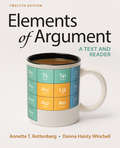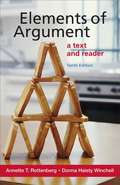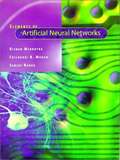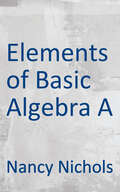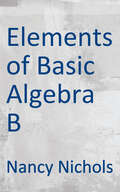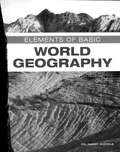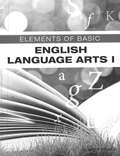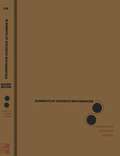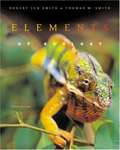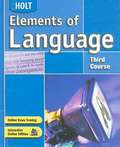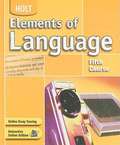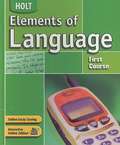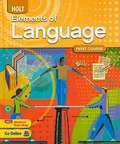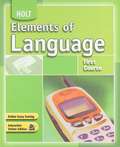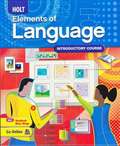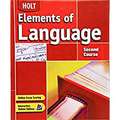- Table View
- List View
Elements of Accounts Part 2 class 12 - GSTB
by Gujarat Sate Board of School TextbooksThe book published by the Gujarat State Board of Textbooks for class 12 has been written in a simple English language keeping in view the standard of class 12 students. This book will also be of great use to those students who are just beginning to learn the subject of Accountancy. A number of illustrations have been given in each chapter and these have been solved in such a simple manner that students can easily understand them. Practical questions given at the end of each chapter are strictly in the serial order of the illustrations. Answers and hints to solve the questions have been given at the end of each question. We are very much confident that after doing the illustrations, students can themselves solve the practical questions. The book contains essay-type, short-anwer type, objective type and practical questions at the end of each chapter so that students may test their understanding of the chapter.
Elements of Argument
by Annette T. Rottenberg Donna Haisty WinchellElements of Argument teaches students how to approach, develop, and defend arguments one element at a time. This comprehensive, accessible text carefully scaffolds argument for students, explaining approaches to argumentation, (including Aristotelian, Toulmin, and Rogerian models as well as Stasis Theory questions), critical reading, and argument analysis. The major components of argumentation--claims, support, assumptions, logic--are explained in depth, and a robust research section shows students how to find, incorporate, and build on existing arguments. This Twelfth Edition has also been updated with more sourced readings than ever before, further reinforcing the importance of research and synthesis. Finally, the anthology includes debates and casebooks on unsettled current issues as well as timeless, classic arguments, making Elements of Argument a comprehensive resource for the argument classroom.
Elements of Argument: A Text And Reader (Tenth Edition)
by Annette T. Rottenberg Donna Haisty WinchellElements of Argument combines a thorough argument text on critical thinking, reading, writing, and research with an extensive reader on both current and timeless controversial issues. It presents everything students need to analyze, research, and write arguments. Elements of Argument covers Toulmin, Aristotelian, and Rogerian models of argument and has been thoroughly updated with current selections students will want to read. It now includes additional support for academic writing, making it a truly flexible classroom resource. An electronic edition is available at half the price of the print book. Read the preface.
Elements of Artificial Neural Networks
by Kishan Mehrotra Chilukuri K. Mohan Sanjay RankaElements of Artificial Neural Networks provides a clearly organized general introduction, focusing on a broad range of algorithms, for students and others who want to use neural networks rather than simply study them. The authors, who have been developing and team teaching the material in a one-semester course over the past six years, describe most of the basic neural network models (with several detailed solved examples) and discuss the rationale and advantages of the models, as well as their limitations. The approach is practical and open-minded and requires very little mathematical or technical background. Written from a computer science and statistics point of view, the text stresses links to contiguous fields and can easily serve as a first course for students in economics and management. The opening chapter sets the stage, presenting the basic concepts in a clear and objective way and tackling important--yet rarely addressed--questions related to the use of neural networks in practical situations. Subsequent chapters on supervised learning (single layer and multilayer networks), unsupervised learning, and associative models are structured around classes of problems to which networks can be applied. Applications are discussed along with the algorithms. A separate chapter takes up optimization methods. The most frequently used algorithms, such as back propagation, are introduced early on, right after perceptrons, so that these can form the basis for initiating course projects. Algorithms published as late as 1995 are also included. All of the algorithms are presented using block-structured pseudo-code, and exercises are provided throughout. Software implementing many commonly used neural network algorithms is available at the book's website. Transparency masters, including abbreviated text and figures for the entire book, are available for instructors using the text.
Elements of Basic World Geography
by Nancy NicholsElements of Basic World Geography by Nancy Nichols
Elements of Basic: English Language Arts I
by Nancy NicholsElements Of Basic English Language Arts I
Elements of Discrete Mathematics - Second Edition
by C L LiuElements of Discrete Mathematics, Second Edition" by C. L. Liu is a comprehensive and accessible textbook that explores fundamental concepts in discrete mathematics. The book covers topics such as logic, set theory, combinatorics, graph theory, and mathematical induction, providing a solid foundation for students studying computer science, engineering, or mathematics. The author emphasizes clear explanations and examples to help readers grasp abstract concepts, making it suitable for both beginners and those seeking a deeper understanding of the subject. With its practical applications in computer science and information technology, the book serves as an essential resource for students and professionals alike, fostering a strong understanding of discrete mathematical structures and their significance in various disciplines.
Elements of Ecology 5th Edition
by Robert Leo Smith Thomas M. SmithWith a modular organization and a beautiful four color art program, the fourth edition of this leading text for non-majors continues to provide a clear presentation of the principles of ecology and illustrate their relation to today's environmental issues. Far-reaching in its coverage, the fourth edition provides the most up-to-date information with a new chapter on global warming and deforestation. It also focuses on ecology as a science, providing the basic background information needed to show the relevance of studying environmental problems on a global scale.
Elements of Educational Psychology (5th edition)
by Hans Raj BhatiaHomeostasis, social behaviour, abnormal behaviour, culture, studies of environmental influence, affection and security form part of Elements of Educational Psychology syllabus for college.
Elements of Language (Third Course)
by Lee Odell Richard Vacca Renée HobbsElements of Language is divided into four major parts: 1. Communications 2. Sentences and paragraphs, 3. Grammar, usage, and mechanics 4. Quick reference handbook
Elements of Language, First Course
by Lee Odell Judith L. Irvin Richard Vacca Renée HobbsA perfect text seldom springs fully formed from your mind; instead, you must plan your text before you write and work to improve it after drafting.
Elements of Language, First Course, Alabama Holt
by Lee Odell Judith L. Irvin Richard VaccaThere are few nations in the world more talked of, or less known, than the Chinese. The confused and imperfect account which travellers have given of their grandeur, their sciences, and their policy, have, hitherto, excited admiration, but have not been sufficient to satisfy even a superficial curiosity.
Elements of Language, Introductory Course
by Judith L. Irvin Renee Hobbs Richard Vacca Lee O'DellTextbook on communication, grammar, and reading the English language.
Elements of Language, Introductory Course, Grade 6, Alabama Holt
by Lee Odell Judith L. Irvin Richard VaccaElements of Language: Introductory Course, Grade 6
Elements of Language, Second Course
by John E. Warriner Lee Odell Judith L. Irvin Renee Hobbs Richard VaccaThis book is a student's guide to the language arts skills and strategies that helps to read, write,create and analyze presentations or media messages.
Elements of Language: Fifth Course
by Lee Odell Judith L. Irvin Richard Vacca Renée HobbsNIMAC-sourced textbook
Elements of Language: First Course
by Lee Odell Judith L. Irvin Richard Vacca Renée HobbsNIMAC-sourced textbook
Elements of Language: First Course
by Lee Odell Judith L. Irvin Richard Vacca Renée HobbsThe book "Elements of Language" is divided into four major parts: Part 1 Communications; Part 2 Sentences and Paragraphs; Part 3 Grammar, Usage, and Mechanics; and Part 4 Quick Reference Handbook.
Elements of Language: Introductory Course
by Lee Odell Judith L. Irvin Renee Hobbs Richard VaccaTextbook.
Elements of Language: Language Skills Practice
by Holt Rinehart WinstonThe Language in Context worksheets include Choices worksheets, Proofreading Applications, Literary Model Worksheets, and Writing Applications to guide students throughout their English lessons.
Elements of Language: Language Skills Practice for Chapters 10-24 (Grade #6)
by Holt Rinehart WinstonHere's your chance to step out of the grammar book and into the real world. You may not notice parts of sentences, but you and the people around you use them every day. The following activities challenge you to find a connection between sentences and the world around you. Do the activity below that suits your personality best, and then share your discoveries with your class.
Elements of Language: Second Course
by Holt Rinehart WinstonElements of Language is divided into four major parts. Part 1 Communication, Part 2 Sentence and Grammar, Part 3 Grammar, Usage, and Mechanics and Part 4 Quick Reference Handbook. These sections ties together the essential skills and strategies students use in all types of communication--reading, writing, listening, speaking, viewing, and representing.

